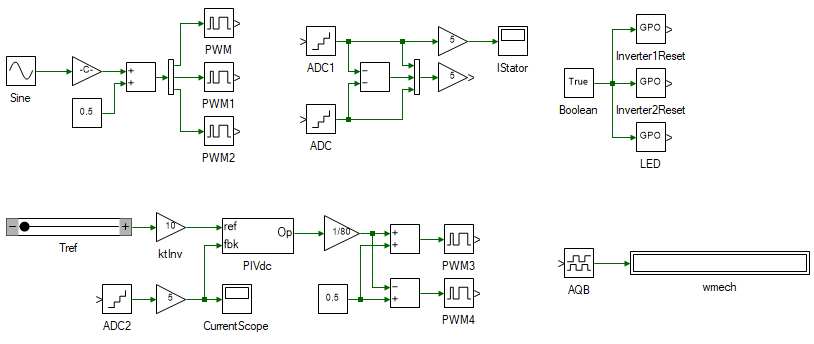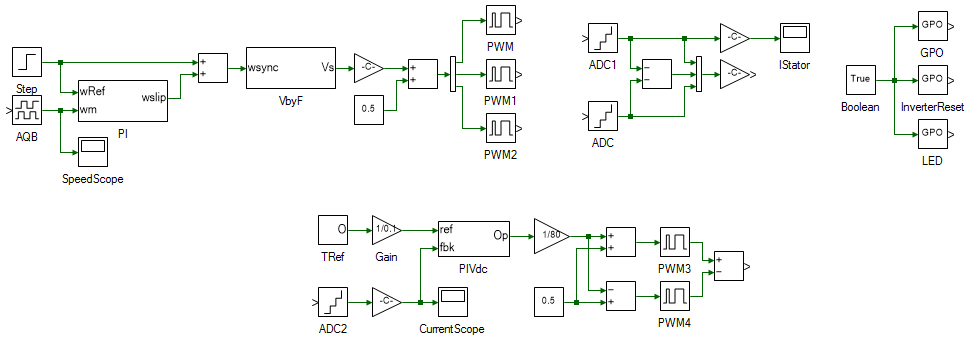In this experiment, the open loop torque-speed characteristic of an induction motor will be measured. As will be seen, the motor speed does not remain a constant and tends to drop linearly with increasing load torque. The torque-speed characteristic will then be measured under closed loop V/f based speed control.
The induction motor electromagnetic torque is directly proportional to the product of the slip and the magnetizing current. From the equivalent circuit in previous experiment, the magnetizing current is given by:
Tem ∝ s × Im(1)
Im = Vm2πf × Lm(2)
where, Vm is the voltage across the magnetizing inductance, f is the frequency ofthe applied stator voltage and Lm is the magnetizing inductance.
Slip s is function of motor poles P and mechanical speed ωmech as given below:
ωsync = 2P2πf(3)
s = ωsync - ωmechωsync(4)
If the stator leakage inductance and stator resistance are negligible, the voltage across the magnetizing inductance, Vm is same as the applied stator voltage Vs.
Im = Vs2πf × Lm(5)
Throughout the motor operation, Im is maintained at maximum rated value given by:
Im,rated = Vs,rated2πfrated × Lm(6)
This ensures that maximum torque is produced for a given slip. If this value is maintained any lower, the dynamic response of the motor as well as the maximum load-torque that can be handled by the motor before it stalls is lowered. If it is maintained higher than the rated, the motor goes into significant magnetic saturation leading to lower order torque pulsations, higher losses etc., which significantly affect the motor operation. Thus, for all other frequency of operation, the voltage is maintained such that the ratio of voltage to frequency is same as that of rated voltage to rated frequency. This ensures that rated magnetizing currents flows through the motor even at lower than rated voltage.
Vsf = Vs,ratedfrated(7)
If ideally the motor had no frictional losses and load torque was zero, then the motor speed ωmech will be proportional to the applied voltage frequency f:
ωmech = ωsync(8)
When frictional loss is accounted for as well as load torque, the motor speed begins to drop, leading to increasing slip so that electromagnetic torque produced (as given by Eqn. 1) can equal the sum of frictional torque and load torque.
In the following section, the rate of change of motor speed for different stator voltage frequency for a changing load torque is determined. This is followed by closed loop speed control where the stator voltage frequency is automatically increased or decreased depending on whether the load torque is increased or decreased so that the steady-state speed remains a constant irrespective of the load.
Open Workbench and pin the Explorer and Properties dock.
Navigate to and open the IMSpeed project file in Experiment8\OpenLoop folder usually in the following location: C:\Program Files (x86)\Sciamble\WorkBench v1\Examples\CUSPLab\BasicDrives.
Expand the project and open the IMVbyF model file shown below:

The bottom part of the model consists of DC motor in current control mode. The top section of the model consists of sine-PWM to control the induction motor stator voltage magnitude and frequency. To the right of it is 3Φ current measurement blocks. The phase A and C current are measured. The phase B current is computed by using the fact that the sum of the 3Φ current equals zero.
Open the properties of the slider tool, Tref. The torque is increased in steps of 0.01Nm. The output of this block is scaled by the inverse motor torque constant, 1/kT and is then set as reference for the DC motor current control loop.
In the kTInv gain block next to the Tref slider, set the gain value to 1/kT, using kT that was obtained in DC motor characterization experiment.
Open the IMParam script file and set the variable Vsrated to 25 and frated to 50.
Connect the induction motor to Inverter 1 (color of the motor terminal must match that of inverter's). Connect the DC generator to Inverter 2 (once again the color of the motor terminal must match that of the inverter's).
Connect the three-inverter module to the DC power supply. Connect the three-inverter to the computer via USB. Connect the generator speed feedback to the three-inverter's Encoder 1 DSUB connector in the back panel.
Within the script file, set variable f to 30.
Turn ON the DC power supply and set the voltage to 40 V.
Ensure that  button on the top dock, to transition to real-time mode, is pressed. Click the run button.
button on the top dock, to transition to real-time mode, is pressed. Click the run button.
Run the model and make note of the steady-state speed for different load. Change the load in steps of 0.01 Nm by using the Tref slider and make note of the rotor speed ωmech in table below.
| Tl (Nm) | ωmech (at f=30Hz) | slip | Tem (Nm) | ωmech (at f=40Hz) | slip | Tem (Nm) | ωmech (at f=50Hz) | slip | Tem (Nm) |
|---|---|---|---|---|---|---|---|---|---|
0.0 |
|||||||||
⋮ |
|||||||||
0.06 |
Stop the model data-logging. Change the applied voltage frequency in the script file to 40 and re-run the model and make note of the speed result for different load torque. Repeat the same for f = 50.
Turn OFF the DC power supply.
In the table above, the electromagnetic torque is calculated using:
Tem = Tl + Tc + Bωmech(9)
Slip is calculated using Eqns. 3 and 4.
This is the torque-slip characteristic of the induction motor, showing the relative drop in speed with increasing load-torque. In the next part of the experiment, a closed loop speed controller is implemented to maintain the speed constant for varying load torque. The details of the controller design are part of the advanced electric drives lab and is not discussed here. For further reading refer to: Induction motor V/f control
Open Workbench and pin the Explorer and Properties dock.
Navigate to and open the IMSpeed project file in Experiment8\ClosedLoop folder usually in the following location: C:\Program Files (x86)\Sciamble\WorkBench v1\Examples\CUSPLab\BasicDrives.
Expand the project and open the IMVbyF model file shown below:

The bottom part of the model consists of DC motor in current control mode same as before. The top section of the model consists of closed loop speed control where the applied stator voltage frequency is increased or decreased using PI controller, based on the error between the desired and the actual rotor speed. The output voltage magnitude is set based on Eqn. 7, such that for given stator votage frequency the voltage magnitude generates the rated magnetizing current.
Turn ON the DC power supply and set the voltage to 40 V.
Ensure that  button on the top dock, to transition to real-time mode, is pressed. Click the run button.
button on the top dock, to transition to real-time mode, is pressed. Click the run button.
Observe the motor speed. It remains a constant at steady-state irrespective of the load torque.
This concludes the experiment on open loop torque speed/slip characterization of induction motor and the introduction to closed loop speed control of the same.
Plot the result of Tem (y-axis) as function of slip (x-axis).
Attach plot of ωm under open loop speed control for all the different frequencies.
Did the motor stall to a stop or motor speed reverse to negative at certain torque step? If so why did it happen? If not, can you explain what will happen to the induction motor speed if the load torque was continuously increased?
Attach plot of ωm under closed loop speed control.